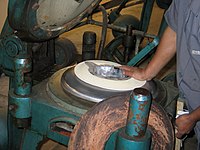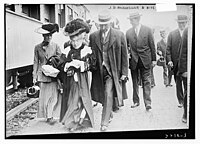Panama
The Panama hat ( also Jipijapa in Spanish-speaking countries ) is a hand- woven straw hat from South America, Ecuador, Peru, Colombia . It is made from the fine, so-called "toquilla straw" of the disk flower family ( Carludovica palmata , also known as the "Panama hat plant").
In 2012 UNESCO recognized the art of weaving hats from “Toquilla fibers” as an intangible cultural heritage .
etymology
The word toquilla for the leaf fibers used for production comes from Spanish. At the time of the conquest of South America , this was a headdress for women in Spain.
The false designation of origin of the "Panama hat" is based on various events. The first confusion of the real country of origin Ecuador with Panama took place in the year 1855, when the one for Napoleon III. intended sombrero de paja toquilla was embarked in Panama. For the French, Panama was the origin of this type of hat.
In the 19th century, goods that were produced in South America without the involvement of companies based in the USA were not allowed to be imported into the USA directly from their countries of origin. The central collection and customs point for their USA imports was Panama alone. Therefore, all these hats, from whichever country they originally came from, wore the customs stamps from Panama. That is why they were called “panama hat” in the USA. This term then established itself in several languages.
When US President Theodore Roosevelt wore an Ecuadorian toquilla straw hat when visiting the Panama Canal in 1906, the photos went around the world and finally established the current name "Panama hat".
Production sites
The Panama hat has been made in the provinces of Manabí and Azuay in Ecuador since 1630 ; The centers of the factories are the cities of Montecristi and Jipijapa ( Province of Manabí ) and Cuenca (Azuay). The largest and best-known exporters are located in Cuenca. In addition, these hats are also made in Peru, Columbia, Nicaragua, Mexico : since a priest introduced the palm plant necessary for production here in 1859, the majority of the inhabitants of the city of Bécal in the state of Campeche have made a living from braiding this special headgear. In the vicinity of Bécal there are around 2000 limestone caves, in which the necessary humidity prevails. On the Zócalo of the place is a big Panama hat Monument.
Manufacturing
Much of the Panama hats does not come in large factories, but in their homes by independent hat - Webern . Often they even cultivate the plants themselves to use their leaves. The stems are briefly boiled in water and then hung up to dry in the shade. Then the leaves (cogollos) are fanned out by hand, with the fingernails or with a pointed metal comb and the thin fibers are pulled out. This results in the hat's subsequent manufacturing quality: the thinner the fibers, the higher the quality. The fibers are now with sulfur vapors bleached in a container similar to the Darren of malt , and then dried.
The hat will be woven by the Weber ( tejedor ) with the Cruzado from the "crown center" (plantilla) begins forth to link several fibers together. A distinction is made between different weaves: the classic Cuenca / Llano ( herringbone, herringbone pattern - more solid) and Brisa (diamond pattern ) as well as Crochet (crocheted), Fancy (different colored straw is woven) and Torcido , New Order . There is also the twisted weave , which creates small air holes in the braid.
When the flat top is finished, the weaver places the blank on a block, usually a large stone that rests on a post . A log is placed on the hat blank, with a small pillow on it, on which the weaver now lies down with his chest, in order to continue to braid the side part and the brim under him . This creates the working posture that is typical for Ecuadorian hat makers , standing and at the same time leaning forward. At the end of this process, the hat is "closed" by usually having another weaver (rematador) tie back the straw at the end of the brim. Then the azocador completes the brim edge.
To complete the blank, the cortador now cuts off any coarsely protruding straw, then washes the hats with a special soap and then bleaches them again. The bleaching takes place again with sulfur vapors or hydrogen peroxide , which results in a very white color (the subsequent sulfur treatments can be dispensed with here). However, bleaching with peroxide weakens the fiber so that it feels rubbery. The hats can also be colored in different colors.
For complete bleaching, as well as for protection and to smooth the joints of the straw , the blank can also be subjected to a special treatment. Here, from the apeleador with a hardwood clapper rubber and sulfur powder carefully into the fabric into a knock and the hat at the same time soft knock. Then the cortador will "fine-shave" the hats again.
The planchador then irons the hat with wooden molds, leather belts and sulfur powder . The first ironing can also be done before the apeleador is processed .
Then the “blocker” brings the blank into its actual shape with moisture , heat and pressure . He first pulls the hat over a unit block, where it is preformed, and then in a second step presses it into its final shape over a more special block. At the end of the work step, the hat brim is shaped , using different wooden shapes (flange) .
Often the hats are not finished on site, because many weavers deliver the blank in a larger factory . As an alternative to the manufacture, a milliner processes and designs the blank in the traditional way and only then forms it into the actual hat.
The thinner the fibers, the more time-consuming and complex the production. As a result, the finest Panama hats can cost several thousand US dollars , the current record being $ 100,000. The middlemen push the price down to meet the demand for bulk goods. Often the traditional way of working - omitting certain procedural steps - and other straw (partly artificial), which is cheaper, is used. The hat then no longer has the original, good usage properties.
Cheaper hats are also equipped with a water- and dirt-repellent impregnation.
The quality of Panama hats is determined according to different systems:
- according to the number of rings ( vueltas ) near the crown. However, this variant is not particularly precise because the weavers work with different weaving styles.
- the density of fibers ( counts ) per square inch
- according to a grade system , although this is not defined uniformly; in general: the higher the grade , the finer.
Blank of a Panama hat in a factory in Cuenca (Ecuador)
use

A good Panama hat can easily be transported rolled up in a can in its country of origin without damaging the fibers or losing its shape. When the humidity is comparatively lower, for example in Europe, the hat can no longer be rolled. In addition, it should not be compressed at the head, otherwise the fibers break easily. The panama hat should not be removed or put on at the crown, but actually only at the brim, in order to avoid fiber breakage caused by compression. But since very few users pay attention to this, the hats are usually equipped with a reinforcement (crown protecting) on the front inside of the crown.
Famous porters
Famous people wearing the Panama hat included: Napoleon III. , Theodore Roosevelt , John D. Rockefeller , Ernest Hemingway , Winston Churchill , Harry S. Truman , Erich Honecker , David Hilbert and Paul Newman . The founder of the Turkish Republic, Mustafa Kemal Ataturk , banned in 1925 by Hat Law men wearing the traditional oriental headgear in favor of hats; his first headdress was a panama hat.
Theodore Roosevelt (center) on a steam dredger near the Panama Canal , 1906
John D. Rockefeller (center) with his wife Laura , around 1910
literature
- Tom Miller: In the footsteps of the Panama hat: a really unusual journey. Translated by Dörte Fuchs and Jutta Orth, Gruner and Jahr, Hamburg 2002, ISBN 978-3-934385-68-9 .
- Tom Miller: The Panama hat trail: A Journey From South America. Morrow, New York 1986, National Geographic , 2001, ISBN 978-0-688-06395-5 .
Movies
- Panama hat style icon. Documentary, Germany, 2011, 52:08 min., Script and director: Jörg Daniel Hissen, production: MedienKontor FFP, GEO, arte , series: 360 ° GEO report , first broadcast: May 21, 2011 by arte, table of contents by Geo , online in three parts.
- Genuine Montecristi Fino (aka Panama Hat) - A Small Glimpse at its Process. Documentary, USA, 2011, 19:11 min., Directors: Joseph Rosenbaum, Pablo Franco, production: MillineryEzone.com, Internet publication: March 25, 2011 on YouTube .
Web links
Individual evidence
- ↑ Traditional weaving of the Ecuadorian toquilla straw has been found on unesco.org, December 2012, accessed on January 25, 2017.
- ↑ Richard Spruce : Palmæ Amazonicæ, sive Enumeratio Palmarum in itinere suo per regiones Americæ Equatoriales lectarum. In: The Journal of the Linnean Society of London . Botany, Volume 11, Issue 50-51, 1869, p. 181, doi : 10.1111 / j.1095-8339.1869.tb00056.x , Taylor and Francis, London 1871, (anthology).
- ^ John Stevens: A new dictionary spanish and english and english and spanish. J. Darby, ... [with eight other authors], London 1726, OCLC 915432958 , online at babel.hathitrust.org, accessed March 6, 2017.
- ^ Annette Lynch, Mitchell D. Strauss: Ethnic Dress in the United States. Rowman & Littlefield, 2014, ISBN 978-0-7591-2150-8 , p. 225, limited preview in Google Book Search.
- ↑ a b c Michael Schmidt: Where does the Panama hat come from? But not from Panama? on tagesspiegel.de, December 30, 2012.
- ↑ Eckehart Wolff: The history of Ecuador and Latin America ( Memento of the original from March 7, 2017 in the Internet Archive ) Info: The archive link was inserted automatically and has not yet been checked. Please check the original and archive link according to the instructions and then remove this notice. (PDF; 1.2 MB), for Radio HCJB : the voice of the Andes , pp. 116–118, on hcjb.de, accessed on March 6, 2017.
- ↑ NIIR Board of Consultants & Engineers: Natural Fibers. National Institute Of Industrial Research, 2005, ISBN 978-81-86623-98-5 , p. 512.
- ↑ Process steps for Panama hat production on brentblack.com, (English), with further links on the website, accessed on March 7, 2017.
- ↑ Panama Weaves and Qualities at panamahats.co.uk, accessed March 7, 2016.
- ↑ Nathaniel Cerf: How to Grade a Panama Hat on hats-plus.com, May 12, 2012, accessed January 25, 2017.
- ↑ Joachim Hoelzgen: Lighter than a sheet of paper. In: Der Spiegel . No. 34/1998.
- ↑ Color of Straw at brentblack.com, accessed March 7, 2017.
- ↑ Cyril Foiret: The Hat for $ 100,000. on trendland.com, August 11, 2009, accessed January 25, 2017.








